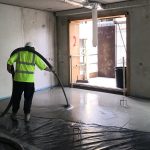Fitting Wall Mounted Boilers Safely
Important Considerations When Locating and Fitting Boilers
As a supplier of secure wall fixings to the gas registered engineer sector we are often asked questions about how to overcome common installation issues relating to securely fixing boilers. Some of these enquiries are from non – registered engineers and keen DIY enthusiasts so we thought it might be helpful to share our thoughts on a wider basis.
Do Not Do It Yourself (Nor use a non-gas safe registered contractor)
We are frankly amazed that our technical department receives calls from ordinary householders who are considering replacing an old boiler and want advice about how many Corefix fixings to use.
When this happens rather than frightening them with scare stories or giving them a rebuke, we direct them to a page on the Gas Safe Register website that explains the folly of this far better than we can.
This is what they say about DIY installations;
“In a world of rising prices, it’s hardly surprising that one in three people say they’d fit a gas appliance themselves to save money. However, some things are worth paying for – and gas safety is one of them. If you work on a gas appliance without being registered, you’re putting you and your family at risk of gas leaks, fires, explosions and carbon monoxide poisoning.”
In many cases householders will be having work done by someone who is using subcontractors to carry out various parts of the job and this may include fitting a boiler and a heating system. The same page gives some excellent guidelines on dealing with the main contractor or project manager to ensure that any gas installation is safely carried out.
“If you work on a gas appliance without being registered, you’re putting you and your family at risk of gas leaks, fires, explosions and carbon monoxide poisoning.”
They also have a very useful fact sheet about what work can legally be carried out by a non Gas Safe registered engineer. What this effectively says is that installation cannot legally be carried out by a non registered person, even if they get a Gas Safe registered person to check the work on completion.
If you are considering doing it yourself or getting ‘a bloke I know’ to do it, we strongly recommend that you stop thinking about DIY at this point and contact a professional registered gas installer. See the Gas Safe factsheet Don’t DIY With Gas for more information.
Where to locate the boiler
In many cases where a replacement boiler is being fitted, its location is often pre-determined by existing pipe work and flues etc. However, you may be making significant changes to the property, so a totally new location may be considered. In this scenario the actual position can therefore be a matter of choice.
The boiler manufacturer Baxi offers the following advice:
“Your boiler should be installed inside a building and can be fitted to any suitable wall strong enough to take its weight when full of water. The boiler’s flue must be able to pass to the outside, either through an outside wall or through the roof”
This advice is a really important consideration at the beginning of your project, even if you are just considering moving the boiler, as there are several options where you will find a suitably strong wall. The most likely will be an external wall of the property which is usually going to be of a brick and block construction or in some cases, particularly in older properties, a solid block construction.
Either will allow the flue to pass directly outside through the wall, although in certain cases you may be able to vent the boiler through the roof if your boiler position is upstairs.
You should never consider internal studwork walls, i.e. plasterboard on a wooden frame, as these will not be able to take the weight of the boiler. Care should also be taken with single skin brick or block walls as the whole of the load will be need to be supported by the wall bearing the weight, with no secondary wall maintaining stability.
Even if using an external wall compromises your desired kitchen design or takes up space you want to use for something else, don’t be tempted to put ‘looks’ above safety.
One other key point to bear in mind is the ambient temperature of the location. Many homeowners put the boiler in a garage or other external building but these are generally unheated and the pipe work could become frozen if the boiler is not used for a prolonged period in cold weather.
How to achieve a secure boiler fixing
The traditional method of attaching items to walls features a drilled hole with some form of plug or anchor to take the screw. These are usually called rawl plugs after John Joseph Rawlings who invented and marketed the Rawlplug as early as 1911. These days most plugs are made of plastic and come in a variety of sizes and styles.
The most important point to consider when choosing the fixing is that it should form a stable contact with the surrounding hole. This is usually achieved by the plug expanding as the screw is tightened. In the main, the depth of a brick or block is around 100mm which is adequate to take an anchor that will support a boiler or other heavy object.
However you should also consider the area around the plug where the weight of the boiler is supported. In many cases there will be a plaster skim over the main wall construction and this will be much weaker than the wall behind. This can cause the plug to deform or sink into the plaster when the weight is attached, weakening the overall integrity of the fixing.
Dot and Dab Walls – The Problems
In modern properties a common practice is to utilise what is a called a dot and dab wall where plasterboard on dabs of concrete or battens is used as the final finish. This can compound the issue mentioned above, because there is a gap between the outer plasterboard finish and the solid wall behind. In this instance the weight of the unit is only partially supported by the plug inserted into the wall with the plasterboard having to support the rest of the load. The greater the load, the higher is the risk of the plug deforming or the plasterboard collapsing into the void. Get more information here on secure dot and dab wall fixings.
What is required here then, is a fixing that securely bridges this gap and spreads the weight across the fixing, which means that when the boiler is attached, the plug does not flex or move and the risk of the plasterboard collapsing is eliminated.
This is the principle behind the Corefix fixing, which has a steel core that bridges the void and ensures that all of the weight of the boiler is supported by the solid wall at the back.
Speed is of the Essence
Especially if you are a professional then time – as they say – is money and the more holes and plugs that need to be used, the longer it will take to complete the job. It makes sense therefore to choose an anchor that is designed to carry heavy loads and not rely on using multiple fixings to do the job. Corefix has a safe working load of 90kg using just four fixings, although they have been factory tested up to 250kg, which is sufficient to support a modern domestic boiler.
We hope that whether you are a homeowner, tradesman or a registered Gas Safe engineer you have found this article helpful and instructive.
For more information see the handy Corefix technical datasheet in our Knowledge Base. Corefix is available in Trade or DIY pack sizes from our online shop.
If you have any questions at all please don’t hesitate to contact us. You can email us or call us on 0800 130 3646.





